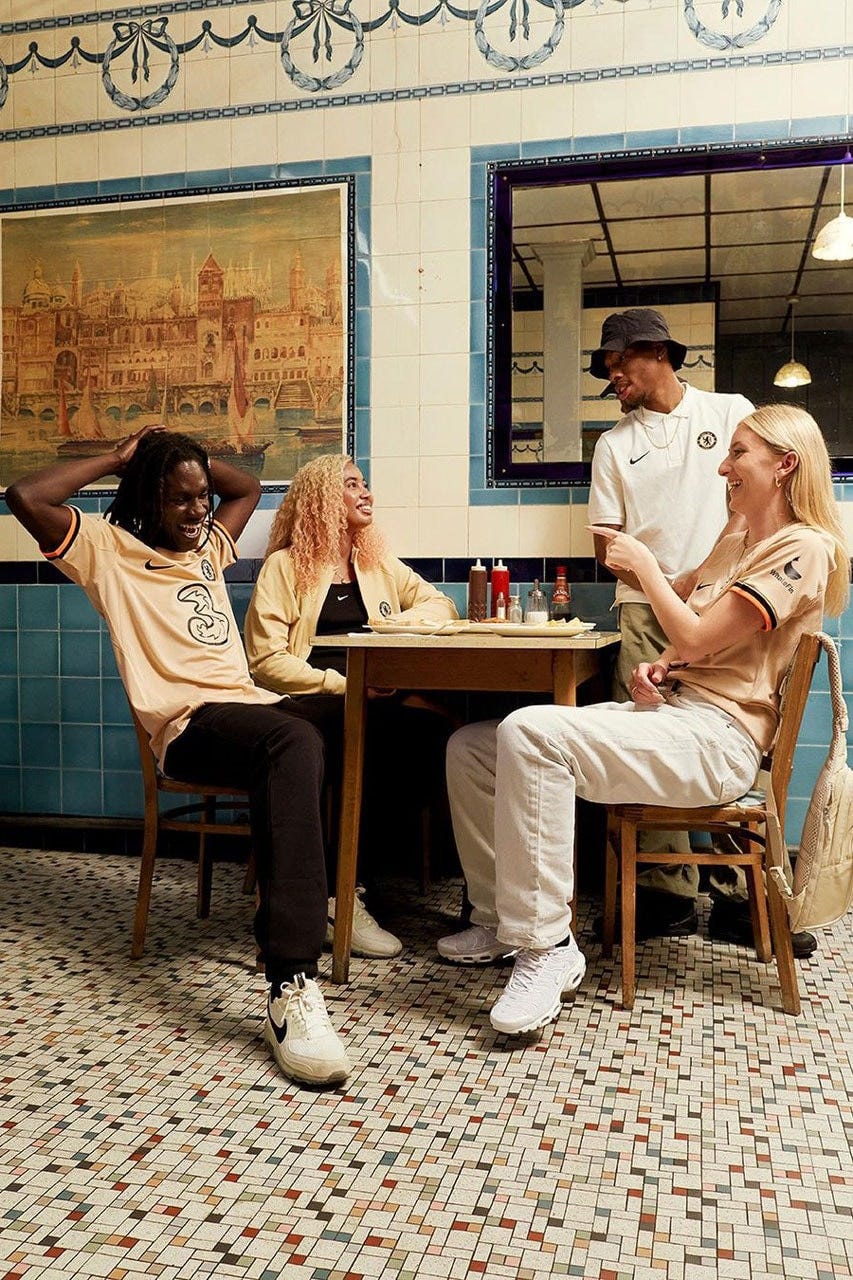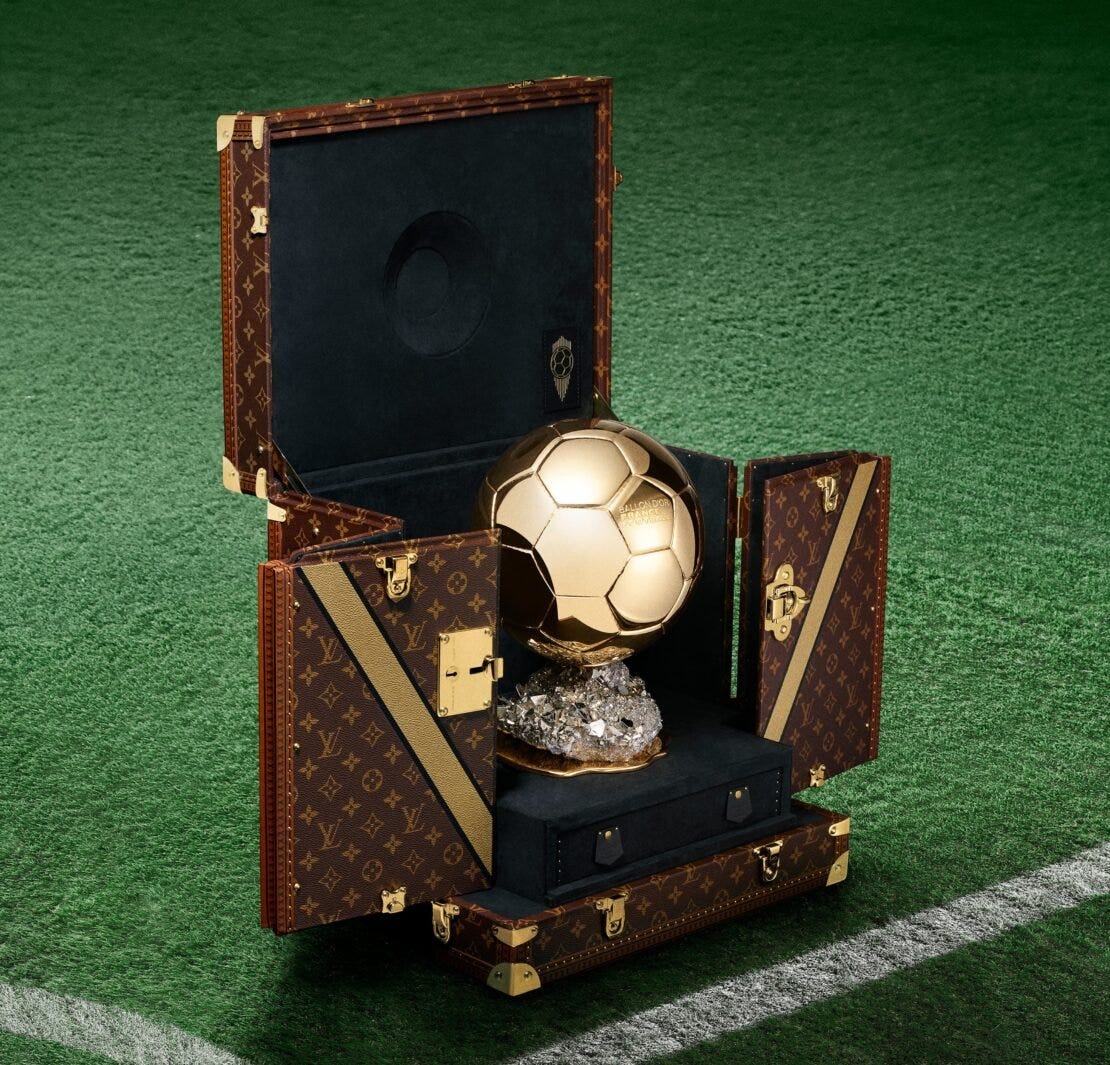Football as Fashion Has Only Just Begun
Style trends and collaborations have affirmed football's place in fashion, but what comes next?
Find a brand with greater global recognition than an elite European football team. No matter where in the world, the emblems, kit colours, and history of clubs like Barcelona, Bayern Munich, Liverpool F.C., Manchester United, and Real Madrid are recognised.
Football is a cultural behemoth far beyond the bounds of the pitch, and fashion is now taking it seriously.
Origins
While the intersection of football and fashion is becoming an ever-increasing hotbed of creativity, the sport’s influence is scattered throughout history. That’s to say, patrons of the game defined several subcultural movements, like Casuals, who were pivotal to the success of brands like Stone Island and C.P. Company in the UK.
Despite this, a degree of cultural separation existed between the two until social media-led style trends and catwalk moments changed everything.
Blokecore
The subcultural style tribes are still alive on the terraces and mimicked by a generation, likely unfamiliar with Green Street or The Football Factory. However, a new era in footballing style was born and catapulted into the zeitgeist by aesthetic style trends–dubbed cores–most notably Blokecore.
The power of TikTok helped Blokecore reach dominant peaks, with analysis and assessment of the trend reaching major news outlets and fashion publications. This innocent fusion of football and fashion was void of team allegiances or even being a fan of the sport, bringing football jerseys into a new market with enormous demand—one that puts style and aesthetics first.
Thanks to Blokecore and a helping hand from a myriad of celebrity style moments, such as Kim Kardashian sporting vintage Roma FC, football officially became “cool,” and, with that, fashion brands and football teams collectively woke up to the selling power of their cross-cultural pollination.
Collabs
In the past two years alone, we’ve witnessed a stream of collaborations, including Prada’s £500 adidas boots, Stone Island x New Balance, Daniel Arsham’s Moncler x Inter collection, Maharishi x Arsenal, OFF-WHITE x AC Milan, and DRAMA CALL x Manchester United, which have set the tone for football and fashion’s migration into being a unified, New Luxury cultural export.
Better yet, football gained significant cultural clout not only from collaborative collections with well-respected fashion brands but also through the appointment of creatives within their commercial chain, such as UNDEFEATED and Kenny Annan-Jonathan as Creative Directors at Birmingham City F.C. and Crystal Palace, respectively.
Although the fashion industry’s acceptance of football’s enormous selling power and cultural pull has largely been realised through primary market channels, with collaborations setting a high bar of desirability for football-related products, secondary markets that buy and trade vintage kits have proven not only an incredible educational resource on the sport and its biggest teams’ history but also a profitable channel that continues to see growth.
The power of nostalgia
Gen-Z, in particular, has embraced the vintage market wholeheartedly—in 2023, a whopping 83% have or were open to shopping secondhand, and 64%’d look for an item secondhand rather than buying new.
In tandem with Blokecore’s influence, this has yielded more-than-favourable results for stores specialising in vintage football shirts like Classic Football Shirts, where particularly rare jerseys can fetch upwards of £3000—prices expected of traditional luxury fashion.
The ever-growing desirability of vintage kits and the success seen on secondary markets is something that brands, teams, and their kit sponsors have actively tried to replicate: adidas recently released a series of 90s national team shirts, DRAMA CALL’s Manchester United collaboration took a 1988 kit, and CORTEIZ launched a riff on Mexico City’s 1988 jersey.
In fashion, nostalgia sells, and this is a truth that remains when football enters the conversation.
Football and fashion’s evolving relationship can be seen at both ends of the market, providing accessibility without negatively affecting desirability, therefore providing brands with ample space for experimentation and directional change.
A willingness to take notice of, understand, and adapt to style, as well as market trends, is something that football teams must possess to maintain a successful relationship with the fashion industry, but what does that look like?
Retro replica kits, like the market for vintage shirts, have been hugely successful for teams. Continually playing to nostalgia, a seasonal recurrence in the fashion industry, is an easy win that allows consumers to buy into a team’s history without paying the premiums rarer pieces beget on the secondary market.
Possibilities for the future
In the future, football teams could leverage their enormous cultural recognition and selling power through luxury fashion models to deliver an exclusive, premium experience.
In the same vein that a Nike Air Jordan purist is willing to pay upwards for a retro rerelease that utilises premium materials, a sneakers’ traditional shape and proportions, branding, and box, football teams could capture specific moments in their history by repackaging classic products in an authentic, premium, and limited manner that feels truly luxurious.
This strategy is also applicable to a team’s seasonal kits. Many teams have begun following in the footsteps of streetwear and high-end fashion by including collaborations within their seasonal deliveries, such as Chelsea F.C.’s Soho Yacht Club-designed third kit or Arsenal’s Maharishi training kit.
Although many products within the Maharishi x Arsenal collection initially hit the secondary market for marked-up resale prices, as you’d expect from a hyped Supreme collab, the collection quickly restocked to settle demand. But why not maintain an exclusivity model for such releases and bolster their desirability as limited-edition luxury products?
Another way that football teams may continue to cement their unique positioning as New Luxury brands is by taking ownership of their manufacturing.
Kit partnerships are big business. Manchester United’s world-record 10-year contract extension with adidas is worth an estimated £900million, while Arsenal’s multi-season adidas deal in the 19/20 season was valued at £300million.
Despite the enormity of these figures, bringing kit manufacturing in-house boasts several benefits: a more sustainable and transparent supply chain and the absence of third-party brand logos, making merchandise appear more premium.
Although no major teams currently have in-house kits, it’s not unheard of, as it’s been achieved by AS Roma during the 13/14 season and Dortmund from 2000-2002.
Through the combination of in-house manufacturing and following the sales models of luxury high-end fashion brands like Louis Vuitton, stripped-back, limited-edition shirts made with premium materials may further elevate the sport’s unique positioning as a New Luxury export.
Regardless of the direction global sports brands decide to take, the crossover between fashion and football will continue to intensify and evolve.
Expect more big-name fashion collaborations that span several seasons, more appointments of fashion-based creatives within football teams’ internal structures, creative experimentation and risk-taking, and a more fashion-conscious approach to branding and merchandising.
Should we be excited? Absolutely.














Great read. I've thought your first sentence true for a while, and it's a mystery to me that the wider culture is only catching on now.
An inspiring read. Thanks for creating and sharing